The American Sentinel and the Crusade to Nationalize Christianity
Douglas Morgan September/October 2009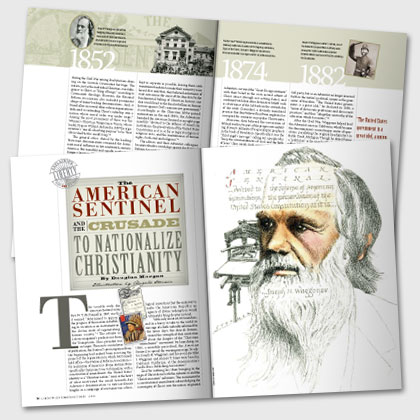
The trouble with the American Sentinel, wrote Rev. W. T. McConnell in 1887, was that it seemed “determined to oppose the progress of this nation in fulfilling its vocation as an instrument in the divine work of regenerating human society.”1 The rebuke to Liberty magazine’s predecessor from the Youngstown, Ohio, preacher was on target. Then in its second year of publication, the Sentinel’s preoccupation from the beginning had indeed been resisting the project of the organization in which McConnell held office—the National Reform Association—for realization of America’s divine destiny. More specifically, that project was to formalize, with a constitutional amendment, the United States’ identity as a “Christian nation.” And, at the heart of what motivated the small Seventh-day Adventist denomination to extraordinary lengths in a campaign of resistance was a theological conviction that the endeavor to make the American Republic an agency of divine redemption would ultimately bring disaster instead.
With only about 26,000 members, and in a hurry to take to the world its message of a faith radically reformed for the latter days, the church demonstrated the strength of that conviction about the dangers of the “Christian amendment” movement by launching, in 1886, a monthly periodical, the American Sentinel, to spread the warning message. Its editor, Joseph H. Waggoner, and his associates Ellet J. Waggoner and Alonzo T. Jones were based in Oakland, California, at the denomination’s Pacific Press Publishing Association.2
Zeal for nothing less than bringing in the reign of Christ drove both the Adventists and the “Christian nation” reformers. The movement for a constitutional amendment acknowledging the sovereignty of Christ over the nation originated during the Civil War among Presbyterians drawing on the Scottish Covenanter heritage. The nation, just as the individual Christian, owed allegiance to Christ as “King of kings,” according to Covenanter theology. However, the National Reform Association also included prominent clergy of many leading denominations. And, it found allies in several other reform organizations dedicated to extending Christ’s rulership over a nation whose moral order was under siege.3 Among the most prominent of these was the Woman’s Christian Temperance Union, whose leader, Frances Willard, declared in 1887 the organization’s “one all-absorbing purpose” to be “that Christ shall be this world’s king.”4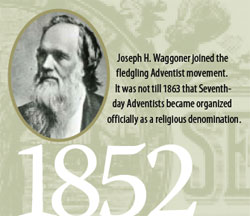
The general ethos shared by the leading Protestant denominations remained the dominant moral influence in late nineteenth-century America. But manifold and rapidly accelerating dangers threatened that dominance—the crime, vice, and poverty rampant in overcrowded cities, the huge influx of immigrants boosting the power base of Roman Catholicism, the influence of secular values in the universities and the large corporations that held sway over the new industrial economy.5 In response, the “Christian nation” advocates, or the “Christian lobby,” to borrow a label from historian Gaines Foster, sought to advance the reign of Christ over the nation by means of legislation—more precisely, federal legislation. While a constitutional amendment remained central to their program, the Christian lobbyists did not wait for its passage to push for other legislation on behalf of numerous aspects of moral behavior, most notably sobriety and Sabbath observance.6
Likewise finding their “all-absorbing purpose” in preparing the way for the coming kingdom of Christ, the Adventists believed that the Lord Himself was soon to bring it about with a cataclysmic destruction of the present order of things and establishment of a new heavens and new earth free of suffering, sin, and death. In the meantime, they wanted church and state to be kept as separate as possible, leaving them with maximum freedom to make their minority voice heard. Not only that, they believed enlistment of state coercion in the cause of the church to be the fundamental failing of Christian history, one that would lead to the final rebellion in human history against God’s noncoercive government.7 Accordingly, as the Christian lobby gained momentum in the mid-1880s, the Adventists launched the American Sentinel as an eight-page monthly “devoted to the defense of American institutions, the preservation of the United States Constitution as it is, so far as regards religion or religious tests, and the maintenance of human rights, both civil and religious.”8
The editors and their Adventist colleagues became relentless watchdogs against the National Reform Association and its allies—not only writing and publishing but countering the organization’s every move by traveling to, holding meetings, and distributing literature wherever the organization held major gatherings or introduced legislation. Since the endeavor to enlist the aid of federal government was the stand-out objective of the Christian lobby, the Adventist challenge would lead to a major conflict in the halls of Congress during 1888 and 1889. But before telling that story, we must step back and take a closer look at these Adventist progenitors of today’s Liberty magazine, and what propelled them.
Joseph H. Waggoner (1820-1889), the Sentinel’s first editor, had been a small-town newspaper editor in Wisconsin when he cast his lot with Seventh-day Adventism in 1852.9 The movement was in its earliest stage—so early that a decade or so was yet to elapse before it had a formal name (1860) and became officially organized as a denomination (1863).10
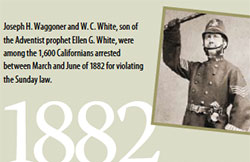 The founders of the movement with which Waggoner connected had been part of the Millerite revival, which led scores of thousands to anticipate, on the basis of biblical prophecy, the second coming of Jesus to take place in 1844. When that did not occur, the eventual Seventh-day Adventists survived the “Great Disappointment” with their belief in the soon second advent of Christ intact (though not setting dates), and combined with that other distinctive beliefs such as observance of the Sabbath on the seventh day of the week (Saturday), a divinely mandated practice that they believed had been neglected or corrupted for centuries in popular Christianity.
The founders of the movement with which Waggoner connected had been part of the Millerite revival, which led scores of thousands to anticipate, on the basis of biblical prophecy, the second coming of Jesus to take place in 1844. When that did not occur, the eventual Seventh-day Adventists survived the “Great Disappointment” with their belief in the soon second advent of Christ intact (though not setting dates), and combined with that other distinctive beliefs such as observance of the Sabbath on the seventh day of the week (Saturday), a divinely mandated practice that they believed had been neglected or corrupted for centuries in popular Christianity.
Moreover, they believed this restoration of biblical truth to be part of the progressive unfolding of events delineated by apocalyptic prophecy in the book of Revelation. Specifically, it was the “third angel’s message,” calling out a people who “keep the commandments of God, and the faith of Jesus” (Rev. 14:12). Such commandment-keeping they understood to include observing the Sabbath on Saturday, as designated by the fourth of the Ten Commandments, rather than on the Sunday of American Christendom. The giving of this message, according to the prophecy, would lead up to the second coming of Christ.
But not without conflict. And here the early Seventh-day Adventists boldly identified the United States as the last in a succession of worldly empires, symbolized by ghoulish beasts in apocalyptic prophecy, that tested the faithfulness of the people of God. Specifically, they identified the beast described in Revelation 13:11-18 as having two “lamblike” horns but speaking like a dragon with the United States. Benevolent in appearance, its stated principles of liberty making it the best government humanity ever produced—“time’s noblest offspring”—the American Republic was nonetheless prone to betrayal of those principles in practice, and would ultimately become the final oppressor of those who put loyalty to God’s commandments first.11
Waggoner quickly became prominent in the movement and was one of several Adventist writers who, in the 1850s, cited slavery as evidence of the menacing reality behind America’s image as a bulwark of liberty. He had been an anti-slavery Democrat until the Compromise of 1850 prompted a switch to the short-lived Free Soil party, but as an Adventist no longer invested faith in the nation’s political system as the guarantor of freedom. “The United States government is a great idol,” he declared in 1858, a “union of democratic professions and slaveocratic practices,” and thus “altogether unworthy of the adoration which it receives.”12
After the Civil War, Waggoner helped lead the Adventist cause in California, which became the denomination’s second major center of operations, paralleling the original headquarters in Battle Creek, Michigan. Though he denied being a “politician” as he once had been as a partisan editor, Waggoner, as editor of the church’s major West Coast periodical, the Signs of the Times, in fact became embroiled in a major conflict in California politics during the early 1880s.
The Adventist mission in California had helped provoke a crisis over the state Sunday law during the 1870s.13 In 1882 the Republican Party, which held the majority in the state legislature, sought to bolster its support for the upcoming election by acceding to demands from conservative Protestant leaders for more rigorous enforcement of the Sunday law passed in 1861. While saloon and theater owners and Jewish and Chinese merchants threatened to turn Sunday into a day of secular commerce and recreation, the Adventists, in their public evangelism, were aggressively attacking the Sunday law’s religious and legal foundations.
Thus, Joseph H. Waggoner and W. C. White, son of the Adventist prophet Ellen G. White, were among the 1,600 Californians arrested between March and June of 1882 for violating the Sunday law. The Pacific Press Publishing Company was shut down.
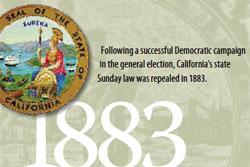 With their eye on the increasing momentum of the National Reform movement, it was just these sorts of developments unfolding in California—only much more severe and on a national scale—that Adventists believed would characterize the final crisis over God’s law just before the return of Christ. With its coercive power marshaled on behalf of a religious agenda, the repressive side of the American beast would overwhelm the Republic’s putative principles of liberty and human rights and persecute dissenters.
With their eye on the increasing momentum of the National Reform movement, it was just these sorts of developments unfolding in California—only much more severe and on a national scale—that Adventists believed would characterize the final crisis over God’s law just before the return of Christ. With its coercive power marshaled on behalf of a religious agenda, the repressive side of the American beast would overwhelm the Republic’s putative principles of liberty and human rights and persecute dissenters.
Rather than passively await the unfolding of prophecy, Adventist action began running in the opposite direction in the 1880s. With the state finding it difficult to gain convictions of those charged with Sunday law violations and the Democratic platform calling for repeal of the law, Waggoner—decidedly Republican in his political sympathies—appealed to the Republican convention in Sacramento to at least include an exemption from the law for observers of a Saturday Sabbath.14
When this failed, the Adventists threw their energies into a successful Democratic campaign in the general election, which in turn led to repeal of the state Sunday law in 1883. Though they numbered only a few hundred, California’s Adventists exerted a disproportionate influence in bringing the Sunday law to the forefront of the political scene and in the law’s demise, which has thus far proven permanent. In the assessment of historian Sandra Sizer Frankiel, Adventists, in California’s formative era, contributed to the state’s rejection of “that bond with traditional Protestant culture” represented by Sunday laws, “in favor of a more open and diverse society.”15
What accounts for the Adventists’ religiously motivated foray into the political arena? Were they themselves now violating the separation of church and state? Would it not be more consistent for them simply to follow their own convictions and trust God to sustain them through the crisis they saw ahead and work things out in accordance with His prophetic Word? Many early Adventists, including pioneer and visionary Ellen White, thought so—or at least wondered about it.
But J. H. Waggoner had two reasons for the Signs of the Times’ involvement in the political struggle over repeal of the Sunday law. The issue, in the first place, had to do with the basic right of religious liberty. In mandating Sunday closings, the law disadvantaged those who observed another day or no day as Sabbath. It was “a direct infringement on our rights as citizens and Christians,” against which Adventists and others affected had a right to defend themselves. Second, the Adventist mission to the world demanded public witness against laws premised on the sacrality of Sunday. Called to proclaim “the commandments of God and the faith of Jesus,” they could not be silent while the fourth (Sabbath) commandment was being “assailed, despised,” and made “subordinate to human policy” in the public arena through Sunday legislation.16
Thus, by the time the first issue of the American Sentinel rolled off the press in 1886 to counter the Christian lobby led by the National Reform Association, Adventists had already begun taking action for religious liberty and developing a rationale for doing so. And they did so now at the urging of the church’s most influential voice, that of Ellen White, despite her earlier misgivings.17
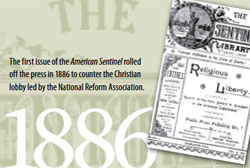 In 1885, in a message entitled “The Impending Conflict,”18 she replaced the logic of passivity in view of divine prophecy with the logic of action consistent with the characteristics of the God the Adventists believed in and the new world they expected Him to bring about. Witness to the God of liberty demanded action on behalf of liberty, even though they did not expect the cause of liberty to triumph through human action.
In 1885, in a message entitled “The Impending Conflict,”18 she replaced the logic of passivity in view of divine prophecy with the logic of action consistent with the characteristics of the God the Adventists believed in and the new world they expected Him to bring about. Witness to the God of liberty demanded action on behalf of liberty, even though they did not expect the cause of liberty to triumph through human action.
“Let none sit in calm expectation of the evil, comforting themselves with the belief that this work [of the National Reform movement] must go on because prophecy has foretold it, and that the Lord will shelter His people,” she wrote. “We are not doing the will of God if we sit in quietude, doing nothing to preserve liberty of conscience.”
Activism for liberty was intrinsic and central to the message of “present truth” that the Adventists were commissioned to spread throughout the world:
“Let the watchmen now lift up their voice and give the message which is present truth for this time. Let us show the people where we are in prophetic history and seek to arouse the spirit of true Protestantism, awaking the world to a sense of the value of the privileges of religious liberty so long enjoyed.”
Indeed, she wrote a year later, such activism was necessary if the Adventists themselves wished, in the end, to show themselves to have been on the Lord’s side in the great, nonviolent struggle against evil.
When the religion of Christ is most held in contempt, when His law is most despised, then should our zeal be the warmest and our courage the most unflinching. To stand in defense of truth and righteousness when the majority forsake us, to fight the battles of the Lord when champions are few—this will be our test.”19
The emergence of the long tradition of advocacy for religious liberty now represented by Liberty magazine can in part be attributed to the Adventists’ pragmatic defense of their own rights as a religious minority, adhering to practices that set them sharply apart from the dominant culture. But the zeal, energy, resourcefulness, and tirelessness of that advocacy cannot be satisfactorily accounted for without recognition of their deep convictions about where history was headed and their apocalyptic role in bearing witness against efforts to make the United States a juggernaut of coercive redemption.
Joseph H. Waggoner drew on extensive and varied experience in activist journalism in 1886 when, as the first editor of the American Sentinel magazine, he took the lead in the Adventist campaign to defend liberty against what he called a program to “nationalize Christianity”20 —a program to establish a legal foundation at the federal level for legislation enforcing Christian morality. A year and a half later, though, as was common in the Adventist cause during that era, he was sent to a new, and far distant, field of labor—Europe. And it was there that his labors came to a sudden end when he died of an aneurysm in 1889.21
It would be left to the young associate editors—Joseph’s son Ellet J. Waggoner and especially Alonzo T. Jones—to lead the Adventists in the cause of religious liberty. It was a cause that would take them to Washington, D.C., and a showdown with the Christian lobby on Capitol Hill.
- Quoted in Alonzo T. Jones, The Two Republics or Rome and the United States of America (Oakland: Pacific Press Publishing Co., 1891), p. 785.
- Seventh-day Adventist Encyclopedia (Hagerstown, Md.: Review and Herald Publishing Association, 1966), vol. 2, p. 571.
- On the National Reform Association and the Christian amendment movement, see Robert Handy, Undermined Establishment: Church-State Relations in America (Princeton: Princeton University Press, 1991), pp. 25-27; Henry F. May, Protestant Churches and Industrial America (New York: Harper & Row, 1963), pp. 42, 43; Daniel G. Reid et al., Dictionary of Christianity in America (Downers Grove, Ill.: InterVarsity Press, 1990), p. 800; Dennis Pettibone, “Caesar’s Sabbath: The Sunday-Law Controversy in the United States, 1879-1892” (Ph.D. dissertation, University of California, Riverside, 1979); Gary Scott Smith, The Seeds of Secularization: Calvinism, Culture, and Pluralism in America, 1870-1915 (Grand Rapids, Mich.: Christian University Press, 1985), pp. 58-69.
- Gaines M. Foster, Moral Reconstruction: Christian Lobbyists and the Federal Legislation of Morality, 1865-1920 (Chapel Hill, N. C.: University of North Carolina Press, 2002), p. 87
- For an overview of these developments see George M. Marsden, Religion and American Culture (Fort Worth: Harcourt Brace Jovanovich, 1990), pp. 96-130.
- Foster, pp. 2-6.
- Douglas Morgan, Adventism and the American Republic: The Public Involvement of a Major Apocalyptic Movement (Nashville: University of Tennessee Press, 2001), pp. 11-44.
- American Sentinel, January 1886, p. 7.
- Woodrow W. Whidden II, E. J. Waggoner: From the Physician of Good News to Agent of Division (Hagerstown, Md.: Review and Herald Publishing Association, 2008), pp. 20, 21.
- For an overview of the origins of Seventh-day Adventism and the movement’s beliefs, see George R. Knight, A Brief History of Seventh-day Adventists (Hagerstown, Md.: Review and Herald Publishing Association, 1999).
- Morgan, pp. 15-20.
- “National Degeneracy,” The Advent Review and Sabbath Herald, Aug. 12, 1858.
- On Adventists and the conflict over the Sunday law in California, see Warren L. Johns, Dateline Sunday, U.S.A. (Mountain View, Calif.: Pacific Press Publishing Association, 1967), pp. 79-94; Eric Syme, A History of SDA Church-State Relations in the United States (Mountain View, Calif.: Pacific Press Publishing Association, 1973), pp. 26-28.
- J. H. Waggoner, “Not a Politician,” Signs of the Times, Sept. 14, 1882 (Supp.).
- Sandra Sizer Frankiel, California’s Spiritual Frontiers: Religious Alternatives in Anglo-Protestantism, 1850-1910 (Berkeley: University of California Press, 1988), pp. 47-55.
- “Sunday in California,” Signs of the Times, Oct. 5, 1882.
- Letter to G. I. Butler and S. N. Haskell, published in Ellen G. White, Selected Messages, book 2, pp. 334, 335.
- Ellen G. White, Testimonies for the Church, 9 vols. (Oakland: Pacific Press Publishing Association [1875?]-1909), 5:711-718.
- Ellen G. White, “Our Present Duty and the Coming Crisis,” The Advent Review and Sabbath Herald, Jan. 11, 1887.
- J. H. Waggoner, From Eden to Eden: A Historic and Prophetic Study (Oakland: Pacific Press Publishing Company., 1888), pp. 174, 175.
- Whidden, p. 142.